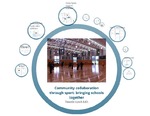Community collaboration through sport: bringing schools together.
| dc.contributor.author | Lynch, TJ | en |
| dc.contributor.editor | Terry, E | en |
| dc.date.accessioned | 2015-12-30T05:19:45Z | |
| dc.date.accessioned | 2016-10-09T18:33:08Z | |
| dc.date.available | 2015-12-30T05:19:45Z | |
| dc.date.available | 2016-10-09T18:33:08Z | |
| dc.date.issued | 2012-09-26 | en |
| dc.identifier.uri | http://hdl.handle.net/10026.1/6478 | |
| dc.description.abstract |
The purpose of this paper/presentation is to share how sport was used to bridge the gap and build relationships between Monash University (Gippsland campus) pre-service education and six rural primary schools during semester one, 2012. Not only was sport used to build partnerships but also to deliver quality Health and Physical Education lessons, offering children sporting opportunities that they may otherwise not receive. The goals established at the Melbourne Declaration on Educational Goals for Young Australians (December, 2008) were “about equity and social justice and improved learning outcomes for our most disadvantaged and isolated students” (Ewing, 2010, p. 127). A commitment to action in achieving these goals included: promoting world-class curriculum and assessment; and improving educational outcomes for the disadvantaged young Australians, especially those from lower socio-economic backgrounds. A large percentage of the Gippsland region population comprises of socio-economically disadvantaged and all six rural schools were located within these areas. Initial discussions with local principals in January (2012) revealed that implementation of the Health and Physical Education (HPE) learning area was carried out by classroom teachers in all but one school, which had a delegated Physical Education (PE) teacher (with no specialist training). Furthermore, some schools outsourced the HPE learning area for the approximate annual cost of $10 000 through the ‘Bluearth’ program. A major problem identified in the 1992 Senate Inquiry into Physical and Sport Education was that “suitably qualified physical education teachers are not being employed to teach physical education and school sport to all children” (Commonwealth of Australia, 1992, p.xiv), as many classroom teachers lack knowledge and confidence for teaching PE (Lynch, 2008; Morgan & Bourke, 2005). In Semester One, 2012 as part of the Bachelor of Primary Education course at Monash – Gippsland, a pathway was created to achieve these national ideals and goals. Primary education university students, choosing the Physical Education (PE) major stream, study the unit EDF3619 Sport and physical activity education. Through amendments made to this unit, objectives involved the implementation of the Friday Sports program. This program ran over five weeks and was the first program of this nature to be implemented within the Latrobe Valley. The Friday Sports program enabled Year 5 & 6 children from the six schools to choose a sport that they would like to participate in during the one hour sessions over the five weeks. Each sport group consisted of 20-25 students, were mixed sexes and mixed schools. The aim of the program was to progressively work towards achieving the objectives of the Sports Education curriculum model; “to develop as competent, literate and enthusiastic sportspeople” (Siedentop, 1994, p. 4). Monash University provided the equipment, the human resource of five teacher education students per group who had planned the five week units, and collaboratively with the local health industry (local leisure and sports centre) provided the stadium and field facilities, all at no cost to schools. Dr. Tim Lynch, Senior Lecturer at Monash University reflects on bridging the gap between the university and the local schools through the medium of sport; provision of quality Health and Physical Education lessons at no cost. He shares: his vision; the benefits for the primary school children; the benefits and interest of the teacher education students; dynamics involved when collaboratively working with a number of stakeholders; and barriers that need to be overcome for future growth and for similar programs to succeed. | en |
| dc.format.extent | 1 - 49 | en |
| dc.language.iso | en | en |
| dc.publisher | Society for the Provision of Education in Rural Australia (SPERA) | en |
| dc.relation.replaces | http://hdl.handle.net/10026.1/4075 | |
| dc.relation.replaces | 10026.1/4075 | |
| dc.title | Community collaboration through sport: bringing schools together. | en |
| dc.type | Conference Contribution | |
| plymouth.author-url | http://media.wix.com/ugd/842c5e_2f1fe2a2a8cb40de807b06118412b602.pdf | en |
| plymouth.date-start | 2012-09-26 | en |
| plymouth.date-finish | 2012-09-28 | en |
| plymouth.date-finish | 2012-09-28 | en |
| plymouth.publisher-url | https://www.spera.asn.au/wordpress/wp-content/uploads/2015/10/SPERA-Newsletter-Aug-2012.pdf | en |
| plymouth.conference-name | The 28th national SPERA (Society for the Provision of Education for Rural Australia) Conference. | en |
| plymouth.publication-status | Published | en |
| plymouth.organisational-group | /Plymouth | |
| plymouth.organisational-group | /Plymouth/Faculty of Arts, Humanities and Business | |
| plymouth.organisational-group | /Plymouth/Faculty of Arts, Humanities and Business/Plymouth Institute of Education | |
| dc.publisher.place | University of Southern Queensland, Toowoomba, Queensland, Australia. | en |
| dc.publisher.place | Toowoomba, Queensland, Australia. | en |
| dcterms.dateAccepted | 2012-05-10 | en |
| dc.rights.embargoperiod | No embargo | en |
| rioxxterms.licenseref.uri | http://www.rioxx.net/licenses/all-rights-reserved | en |
| rioxxterms.licenseref.startdate | 2012-09-26 | en |
| rioxxterms.type | Conference Paper/Proceeding/Abstract | en |
| plymouth.oa-location | https://www.spera.asn.au/wordpress/wp-content/uploads/2015/10/SPERA-Newsletter-Aug-2012.pdf | en |


